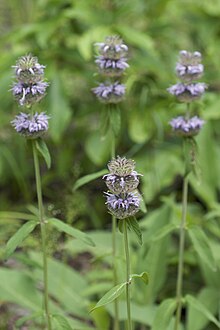Blephilia ciliata
| Blephilia ciliata | |
|---|---|

| |
| Inflorescences | |
| Scientific classification | |
| Kingdom: | Plantae |
| Clade: | Tracheophytes |
| Clade: | Angiosperms |
| Clade: | Eudicots |
| Clade: | Asterids |
| Order: | Lamiales |
| Family: | Lamiaceae |
| Genus: | Blephilia |
| Species: | B. ciliata
|
| Binomial name | |
| Blephilia ciliata | |
| Synonyms[1] | |
|
List
| |
Blephilia ciliata is a species of herbaceous perennial plant in the Lamiaceae (mint) family native to central and eastern North America. It is commonly called downy wood mint.[2] Other common names include downy pagoda-plant, sunny woodmint and Ohio horsemint.[3]
Description
[edit]Blephilia ciliata grows as a perennial herb reaching 40 to 80 cm (15.5 to 31.5 in) high.[4] The central stem is generally unbranched, except if it is damaged, side stems may form. As with many other plants in the mint family, the stem is 4-angled (square).[5] Leaves are sessile, lightly toothed, and mildly fragrant when crushed.[6] They are broadly ovate to lanceolate, are arranged oppositely on the stem, and measure up to 9 cm (3.5 in) long and 4 cm (1.5 in) across.
The inflorescence is a spike toward the end of the stem with 1 to 5 dense, headlike clusters spaced separately along the stem. Each of these clusters has numerous flowers resting on a pair of leaflike fringed bracts slightly longer than the flowers.[7] Flower petal color can range from blue, purple or white.[3]
Taxonomy
[edit]Carl Linnaeus described the downy wood mint as Monarda ciliata, before George Bentham gave it its current binomial name.[8]
Distribution and habitat
[edit]B. ciliata is native in the United States from Oklahoma to the west, Mississippi to the south, Massachusetts to the east, and the Canadian border to the north. In Canada, it is native in Ontario.[9] Its habitats include dry open woods and thickets, clearings, fields, and roadsides.[6]
Ecology
[edit]Flowers bloom from May to August and attract numerous bees, plus butterflies and skippers.[5]
Uses
[edit]It has traditionally been used by the Cherokee to make a poultice to treat headaches.[10]
References
[edit]- ^ "Blephilia ciliata". Plants of the World Online. Royal Botanic Gardens, Kew. 2021. Retrieved 12 January 2021.
- ^ "Blephilia ciliata". Canadensys. Université de Montréal Biodiversity Centre. 4 September 2020. Retrieved 12 January 2021.
- ^ a b Lady Bird Johnson Wildflower Center (26 August 2015). "Blephilia ciliata". University of Texas at Austin. Retrieved 12 January 2021.
- ^ Miller, James Howard; Miller, Karl V. (2005). Forest plants of the Southeast and their wildlife uses. University of Georgia Press. p. 22. ISBN 0-8203-2748-4.
- ^ a b "Downy Wood Mint (Blephilia ciliata)". www.illinoiswildflowers.info.
- ^ a b "Blephilia ciliata - Plant Finder". www.missouribotanicalgarden.org. Retrieved 2021-12-18.
- ^ "Blephilia ciliata page". www.missouriplants.com.
- ^ Bentham, George (1836). Labiatarum genera et species: or, A description of the genera and species of plants of the order Labiatae; with their general history, characters, affinities, and geographical distribution. London: James Ridgway and Sons. p. 319.
- ^ "NatureServe Explorer 2.0". explorer.natureserve.org.
- ^ Hamel, Paul B.; Chiltoskey, Mary U. (1975). Cherokee Plants and Their Uses - A 400 Year History. Sylva, N.C.: Herald Publishing Co. p. 45. Archived from the original on 4 December 2013. Retrieved 4 January 2013.
- NatureServe secure species
- Lamiaceae
- Flora of the Great Lakes region (North America)
- Flora of the Southeastern United States
- Flora of the Northeastern United States
- Flora of the North-Central United States
- Plants described in 1753
- Plants used in traditional Native American medicine
- Taxa named by Carl Linnaeus
- Taxa named by George Bentham

